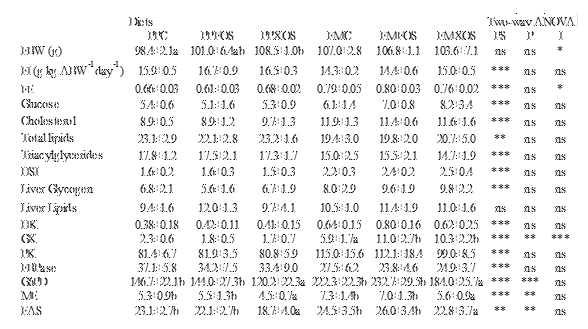Potential of short-chain fructooligosaccharides (scFOS) and xylooligosaccharides (XOS) in modulating glucose and lipid metabolism in European sea bass (Dicentrarchus labrax)
Introduction
Prebiotics are emerging functional products, mostly of oligosaccharide nature, that are selectively fermented by gut specific-health promoting bacteria mainly leading to production of short-chain fatty acids as end products of fermentation (Gibson and Roberfroid, 1995). Depending on their colonic fermentation, it has been reported that prebiotics such as FOS and XOS can alter glucose and lipid metabolism in mammals (Delzenne et al., 2008; Broekaert et al., 2011). The present study aimed to assess the role of scFOS and XOS, incorporated into plant ingredients or fish meal based diets, on European sea bass glucose and lipid metabolism through measurement of hepatic activity of key enzymes of glycolytic, gluconeogenic and lipogenic pathways.
Material and Methods
European sea bass juveniles (60g) were fed isoproteic (46% protein) and isolipidic (15% lipids) diets based on fish meal (FM diets) or plant ingredients (PP diets; circa 30FM:70PP, blend of soybean meal, wheat meal, wheat gluten and corn gluten) as main protein sources. Four other diets were formulated similar to these control diets (FMC; PPC) and including 1% scFOS or XOS (diets PPFOS, PPXOS, FMFOS and FMXOS). Each diet was fed to triplicate groups of fish twice daily (10 and 16h) until visual satiation, 6 days a week, during 9 weeks. At the end of the trial, 3 fish per tank were sampled six hours after the morning meal for collection of blood from the caudal vein, for plasma metabolites analysis, and of livers for composition analysis. Livers of 3 other fish were sampled at the same time for measurement of activities of key enzymes of glycolytic (hexokinase, HK; glucokinase, GK; and pyruvate kinase, PK), gluconeogenic (fructose-1,6-bisphosphatase, FBPase) and lipogenic (glucose-6-phospahte dehydrogenase, G6PD; malic enzyme, ME; and fatty acid synthetase, FAS) pathways.
Results
In fish fed the PP diets, but not the FM diets, growth performance was improved by XOS supplementation. Feed intake (FI) was higher in fish fed the PP diets while feed efficiency (FE) was higher in FM-fed fish. Prebiotics had no effect on FI and FE. Plasma glucose and cholesterol were higher in fish fed FM diets while plasma total lipids and triacylglycerides were higher in PP-fed fish. Plasma metabolites were unaffected by dietary prebiotic supplementation. Hepatosomatic index (HSI) and liver glycogen content were higher in fish fed FM diets while liver lipids were unaffected by dietary protein source. Hepatic composition was unaffected by prebiotics. Activity of glycolytic and lipogenesis enzymes was higher in fish fed the FM diets, while gluconeogenic enzyme activity was higher in the PP groups. Independently of protein source, dietary XOS supplementation reduced the activity of lipogenic enzymes while both scFOS and XOS increased GK in FM diets.
Table I - Growth performance, feed utilization (n=3), plasma metabolites (glucose, cholesterol, total lipids, triacylglycerides), HSI, liver composition (g 100g-1 liver), hepatic glycolytic (HK, GK and PK), gluconeogenic (FBPase) and lipogenic (G6PD, ME and FAS) enzyme activities (mU mg protein-1) (n=9) in European sea bass fed the experimental diets. Mean values and standard deviation (± SD) are presented for each parameter. Two-way ANOVA: ns, non-significant (P > 0.05); *P < 0.05; **P < 0.01; ***P < 0.001. In case of interaction, one-way ANOVA was performed for prebiotics within each protein source and mean in the same line with different letters are significantly different. PS- Protein Source; P- Prebiotic Source; I- Interaction; ABW- Average Body Weight.
Conclusions
Fish fed FM diets had increased glycolysis and lipogenesis, which are related with the higher dietary starch content of these diets (20% in FM diets against 13% in PP diets). Dietary supplementation with XOS decreased lipogenesis, independently of dietary protein source, and improved growth performance in fish fed the PP diets. In fish fed FM diets, dietary supplementation with scFOS and XOS increased GK activity, a key enzyme of glycolytic pathway.
Acknowledgements
This work was partially funded by Projects AQUAIMPROV (reference NORTE-07-0124-FEDER-000038) and PEst-C/MAR/LA0015/2011, co-financed by the North Portugal Regional Operational Programme (ON.2 - O Novo Norte), under the National Strategic Reference Framework (NSRF), through the European Regional Development Fund (ERDF), and through the COMPETE - Operational Competitiveness Programme and national funds through FCT - Foundation for Science and Technology, respectively. I. Guerreiro and P. Enes were supported by FCT (SFRH/BD/76139/2011 and BPD/39688/2007, respectively).
References
Broekaert W.F., C.M. Courtin, K. Verbeke, T.V. De Wiele, W. Verstraete, and J.A. Delcour. 2011. Prebiotic and other health-related effects of cereal-derived arabinoxylans, arabinoxylan-oligosaccharides and xylooligosaccharides. Critical Reviews in Food Science and Nutrition 51: 178-194.
Delzenne N.M., P.D. Cani, and A.M. Neyrinck. 2008. Prebiotics and lipid metabolism. p.183-192. In: Therapeutic microbiogy: probiotics and related strategies. ASM Press. Versalovic J. and M. Wilson (Eds.). ASM Press, Washington DC. 403p.
Gibson, G.R., Roberfroid, M.B., 1995. Dietary modulation of the human colonie microbiota: introducing the concept of prebiotics. Journal of Nutrition 125: 1401-1412.
